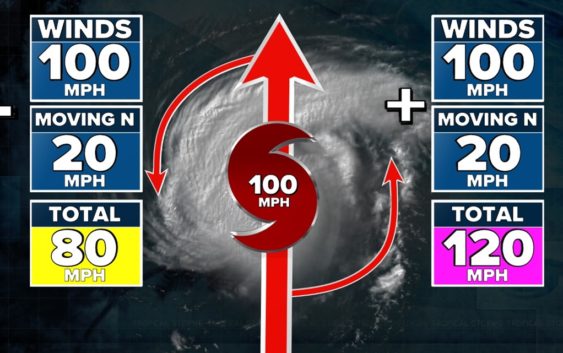- Fake job seekers are flooding the market, thanks to AI
- One set of evacuation orders lifted in Caldwell County after wildfire contained
- 'We gutted every building' | Chimney Rock rebuilding after Hurricane Helene
- 'We gutted every building' | Chimney Rock rebuilding after Hurricane Helene
- Debris from Hurricane Helene provides fuel, complicates containment for spring wildfires
Weather IQ: The 'dirty side' of a hurricane

Every part of a hurricane is dangerous, but one side and quadrant is far stronger than the other with much higher threats.
CHARLOTTE, N.C. — Hurricanes can devastate coastal areas with epic winds, dangerous storm surges and even spawn multiple tornadoes. But one side of the storm is far worse than any other, called, the dirty part of the storm.
What is the ‘Dirty’ side of the storm?
Hurricanes rotate counterclockwise and when that rotation of the storm matches the direction it is moving, it enhances the winds.
For example:
A hurricane producing 100 mph winds moving north at 20 mph would have a max speed of 120 mph on the right side since you add these numbers together.
But on the left side, the winds are fighting against its forward push, so the forward speed is subtracted making the totals winds 80 mph. That’s a big difference.
All sides of a hurricane and tropical storm are dangerous but The strongest side of a hurricane is the right side based on the direction it is moving. AKA the dirty side.
So a storm moving north has a right dirty side. A storm moving west shows the dirty side is on the northern side
Meteorologists call this the dirty side because this is where the worst weather occurs.
RELATED: What month has the most hurricanes?
To narrow this down further, the right front quadrant is where the peak winds are reported.
This is also the part of the hurricane that has the worst storm surge along the coast.
Using Hurricane Ian as an example, the worst storm surge would occur here (see above), where the counterclockwise winds are pushing water onshore. The faster the storm is blowing and moving, the higher the storm surge. The opposite side will blow water offshore reducing the storm surge threat.
This dirty side also has the most moisture leading to the heaviest rainfall rates. And has the most wind shear which makes tornadoes and waterspouts more likely, especially in that right front quadrant.
RELATED: Weather IQ: How hurricanes form
Wake Up Charlotte To Go is a daily news and weather podcast you can listen to so you can start your day with the team at Wake Up Charlotte.
SUBSCRIBE: Apple Podcasts || Spotify || Stitcher || TuneIn || Google Podcasts
All of WCNC Charlotte’s podcasts are free and available for both streaming and download. You can listen now on Android, iPhone, Amazon, and other internet-connected devices. Join us from North Carolina, South Carolina, or on the go anywhere.